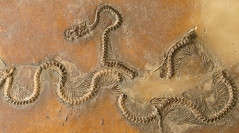

 Geodiversitas
43 (1) - Pages 1-24
Geodiversitas
43 (1) - Pages 1-24A nearly complete skeleton of an erycine boid is described from the Ypresian-Lutetian (early-middle Eocene) site of Messel, Germany, for which we propose the name Rageryx schmidi n. gen., n. sp. The animal had a total length of c. 52 cm, with c. 258 vertebrae. In skull proportions it is similar to ungaliophiine boids, especially Ungaliophis, and to Tropidophis. The proportions and distinctive accessory processes of the distal caudal vertebrae that are common to all living erycine boids are present in the specimen, although the processes are not as elaborate as in many extant species. The premaxilla was not protruded to form a wedge-shaped snout, and the nasofrontal joint does not appear to show any special buttressing, unlike in many burrowing snake species. Furthermore, the inner ear lacks adaptations to an actively burrowing mode of life. We conclude that the animal, while it was probably secretive, was not fossorial. Phylogenetic analyses using maximum parsimony and Bayesian inference place Rageryx schmidi n. gen., n. sp. unambiguously on the stem of the North American clade (Lichanura + Charina). If this relationship is accurate, it provides further support for a common Euro-American squamate fauna in the early Eocene. The majority of known Messel snake taxa are small-bodied with a small gape, suggesting that such forms may have played a greater role in the early evolutionary radiation of Booidea than their present diversity would suggest.
Boidae, snakes, Eocene, Germany, Messel, biogeography, new genus, new species